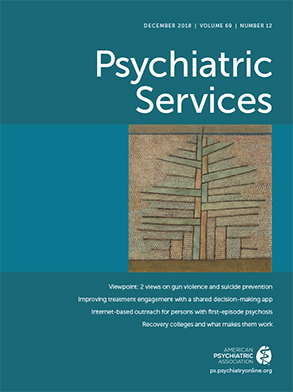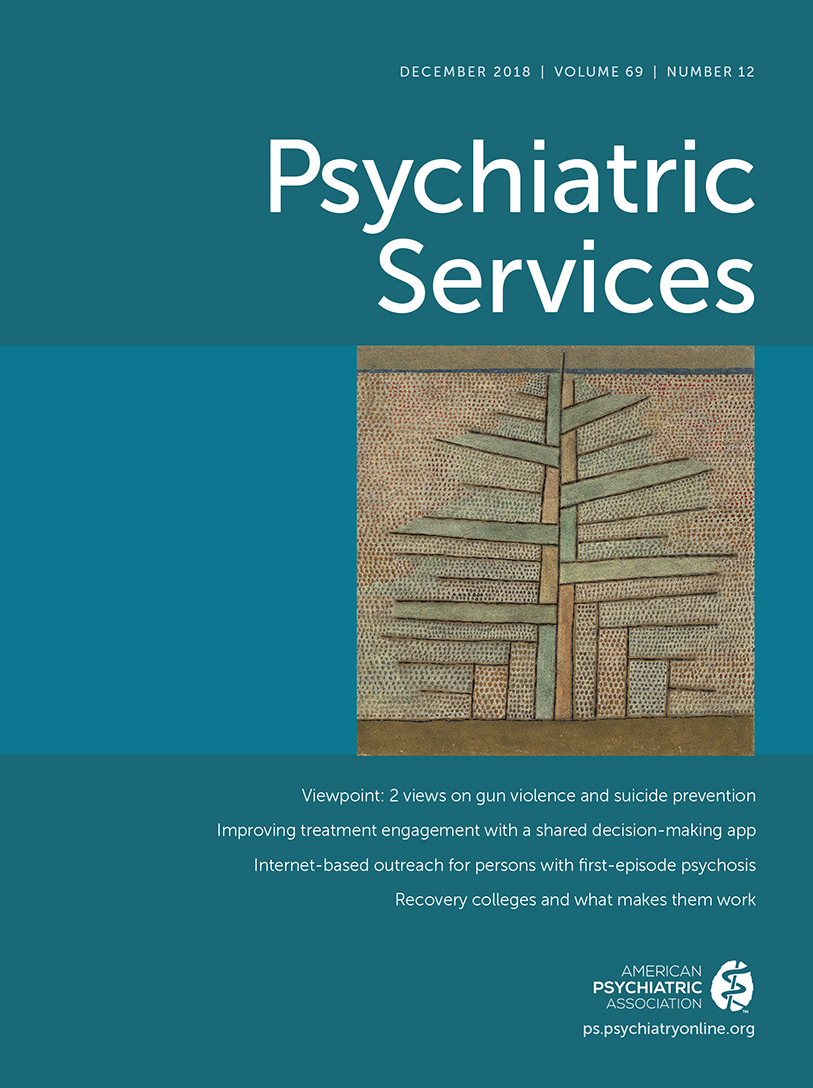Access to mental health services is an ongoing and ever-increasing need. Discussion of this topic often focuses on access as it relates to the ability to pay for care or access related to provider availability. However, access to care is also negatively affected by the relatively low show rates reported for those attending their initial appointments at outpatient psychiatric clinics. Various studies have found show rates as low as 40% (
1). While some people miss their initial appointment because they no longer need the services, other studies have shown that age (
2,
3), socioeconomic status (
4), ethnicity (
2), medication compliance (
2), health insurance status (
2), and appointment waiting time (
3) can influence the show rate for new-patient appointments.
The impact of nonattendance is multifold. It directly affects the patients who are seeking care and delays the onset of their treatments. It also delays the onset of treatment for other patients who are still waiting to be seen. For patients recently discharged from an inpatient unit, initial outpatient non-attendance predicts a higher rehospitalization rate (
5). From a program perspective, missed appointments drain available resources, and as new-patient appointments are typically longer than follow-up appointments, the impact is even greater. Additionally, staff morale can be affected by frequent missed appointments.
Although missed appointments are an understandable phenomenon, there are few practical guides on how to address this issue. Batscha et al. (
6) implemented an inpatient transition program to facilitate recently discharged inpatients in attending their first outpatient appointment. They found that the show rate increased from 44% to 92%. Boyer et al. (
7) reported on three inpatient clinical interventions that significantly increased the likelihood that patients would engage in outpatient treatment following discharge. Critical time intervention (CTI) was used to enhance the engagement of those with schizophrenia and other serious mental illnesses in outpatient care following hospitalization (
8). In a randomized controlled trial, individuals assigned to receive CTI had a shorter wait time to their first outpatient appointment and were more likely to attend their appointment compared with the control group. Smith et al. (
9) reported on “best practice providers” who, through outreach prior to the initial appointment, obtained first appointment show rates of 70%−80%. Zanjani et al. (
10) found that providing one to two telephone-based motivational sessions with a behavioral health specialist significantly increased patient attendance at the initial psychiatric appointment. This column describes initiatives implemented in a hospital-based community psychiatry outpatient program to improve new-patient show rates for initial evaluations.
Background and Initiative Development
The Johns Hopkins Community Psychiatry Program provides ongoing outpatient psychiatric care to over 1,100 patients. Sixty percent of program patients have a diagnosis of an affective disorder, 30% have some form of psychotic illness, 10% have anxiety or adjustment disorders, and up to 50% have a current or past substance or alcohol use disorder diagnosis. Within the program, new patients can be divided into three groups: people discharged from inpatient units, self-referrals, and patients referred by other providers or programs. The program focused its initiatives on the show rates of the discharged inpatients and the self-referrals.
A different approach was adopted for each group, involving a six-month pilot for the discharged inpatients and a three-month pilot for the self-referrals. As a first step, a multidisciplinary no-show committee composed of scheduling staff, therapists, nurses, and physicians met monthly to review and discuss the challenges associated with the program’s no-show rate. The committee developed initiatives to address this issue and continued to meet monthly after their implementation.
Patients referred from the inpatient units were given appointments to attend a postdischarge orientation group session within zero to five working days of their discharge. The program held these sessions weekly for one hour to provide newly discharged patients with program information and to review the general goals of treatment; during the orientation session, patients completed program admission paperwork. At the end of the orientation session, patients were given an appointment for an initial evaluation with a psychiatrist. This appointment was scheduled for either the same day (urgent) or within two working days (routine). This weekly group format ensured that all patients had an appointment within five working days of discharge. Aside from implementing the orientation group, there was no other procedural change introduced. Additionally, the diagnostic profile of the inpatients referred pre- and postinitiative implementation was similar.
For self-referrals, the program implemented a walk-in screening clinic. The clinic was held twice a week from 8 a.m. to 9:15 a.m. Patients requesting new evaluations were informed about the walk-in screening clinic and the date and time of the next clinic. No appointments were given for the screening clinic. Licensed therapists completed brief (10- to 15-minute) screening assessments of all patients who walked in. The information gathered included the reason for, appropriateness of, and urgency of the self-referral. Patients who met criteria to attend the program were given an appointment for an initial evaluation with a psychiatrist. This appointment was scheduled for either the same day (urgent) or within three working days (routine). The emphasis of both initiatives was to facilitate easier and quicker access to care for the patients involved.
Results
Inpatient referrals.
In the six months prior to the implementation of the pilot initiative, 170 inpatients were referred and scheduled for an initial evaluation appointment within, on average, five working days of their discharge. Of these, 78 attended their initial evaluation, a show rate of 46%. The total physician time scheduled to complete the initial evaluations was 127.5 hours and the total time used was 58.5 hours, leaving 69 hours (54%) of unused physician time.
During the six months after the implementation of the initiative, 122 inpatients were referred to and given appointments for the postintake orientation group. Appointments were within, on average, three working days of discharge. Sixty-eight (56%) patients attended the group and were scheduled for an initial evaluation within, on average, 1.5 working days. Fifty of these 68 patients subsequently attended the initial evaluation appointment, for a show rate of 74% (χ2=4.19, df=1, p=.04). Overall, the average monthly show rate for an initial evaluation since the completion of the six-month pilot has been 75%.
The total physician time scheduled to complete initial evaluations was 51 hours: 37.5 hours (74%) were used and 13.5 hours (26%) were unused. Twenty-four hours of a therapist’s time were scheduled and used to provide the orientation group. Overall, there was a 60% reduction in the scheduled physician time needed and a 28% increase in the utilization of the physician time that was scheduled.
Self-referrals.
There were 131 self-referrals to the program in the three months prior to the start of the pilot. All were given appointments for an initial evaluation, and of these, 62 (50%) showed. The average wait time for an appointment was 20 working days. The total physician time scheduled to complete initial evaluations was 196.5 hours: 93 hours (47%) were used, leaving 103.5 hours (53%) unused.
After implementation of the initiative, 148 self-referrals presented at the walk-in screening clinic over the three-month pilot period. Of these, 124 were given an appointment for an initial evaluation; 14 were referred elsewhere mainly because of insurance eligibility issues. The average wait time for an initial evaluation was three working days. One hundred ten patients showed for their initial evaluations, for a show rate of 89% (χ2=–5.17, df=1, p=.023). The average monthly show rate for these appointments over the subsequent 24 months has been 84%.
The total physician time scheduled to complete initial evaluations during the three-month pilot period was 186 hours. Of these, 165 hours (89%) were used, leaving 21 hours (11%) unused. For therapist time, 108 hours were reserved and used to complete the screening clinics. Overall, there was a 5% reduction in the scheduled physician time needed and a 42% increase in the utilization of the physician time that was scheduled.
Impact of initiatives and further initiative refinement.
The results of these two initiatives had a positive impact on patients and program operations. Patients had quicker access to outpatient care. Inpatients had an initial appointment within, on average, three working days postdischarge, and self-referrals were screened on the day they attended the walk-in clinic. Both groups obtained appointments for initial evaluations within 1.5 (inpatients) or three (self-referrals) working days of their first contact, and the show rates for these appointments increased significantly. Quicker access to care will likely lead to improved patient outcomes, although exploring the evidence is outside of the scope of this report.
Both initiatives led to increased use of physician scheduled time. Although therapist time was used to complete screenings and conduct postdischarge orientation groups, the cost needed to cover this time was offset by the increase in physician productivity. Additionally, support staff spent less time rescheduling patients who missed their appointments. The program has continued to adapt and refine the initiatives since implementation in response to clinical demands and external forces that affect the program. For example, with the introduction of the Patient Protection and Affordable Care Act, the numbers of people presenting at the self-referral screening clinic gradually increased from an average of 15 patients per clinic to a maximum of 64. At that point, it was felt that to continue conducting the initiative in its current design was both unsafe and undignified for patients. An appointment system for the self-referral screening clinic was introduced that facilitates screening individuals in a safe, respectful manner. This change has been successful, and the attendance rate for the initial evaluation remains high.
The postdischarge orientation group for inpatient referrals now occurs twice a week. This has reduced the wait time from discharge to orientation group from within five to within three working days. With this initiative patients continue to be seen quickly at the program for an initial evaluation. However, a substantial number of patients still do not show for the postdischarge orientation group. These individuals are therefore not scheduled for an initial evaluation and, despite repeated outreach attempts, they are often lost to follow-up. While the program benefits from not needlessly scheduling a significant amount of physician time for these patients, it remains a concern that they do not follow up despite their recent hospitalization. The no-show committee is developing initiatives to improve attendance at the postdischarge orientation for this vulnerable group. Building on the strategies successfully implemented by others (
6–
8,
10) may help in addressing this issue.
The data-driven assessment, modification, and refinement of clinical initiatives promote continuous quality improvement, which is an important focus for all programs to have. The value in reporting on these initiatives is that they were implemented into a routine clinical setting, which should make them relatively easy to replicate in other clinical settings.
Conclusions
Improving patients’ compliance with their initial mental health evaluation appointments is beneficial to patients, providers, and programs. The initiatives adopted here were simple and straightforward to implement. They led to substantial increases in the show rates for the groups involved at this program and improved the efficiency of the program. Additionally, the ongoing modifications demonstrate the importance of continuously using data to reassess and refine any initiatives so that they meet the ongoing needs of the patient, providers, and program. Future planned initiatives include addressing the show rate for the postdischarge orientation group and addressing the show rate of current program patients.
Acknowledgments
The author acknowledges the staff and patients of the Johns Hopkins Community Psychiatry Program and the members of the no-show committee: Donna Batkis, L.C.S.W.-C., Kathleen Malloy, L.C.P.C., Jennifer Meuchel, M.D., Holly Sater, L.C.P.C., Latrice Smith, and Tyronda Smith.

